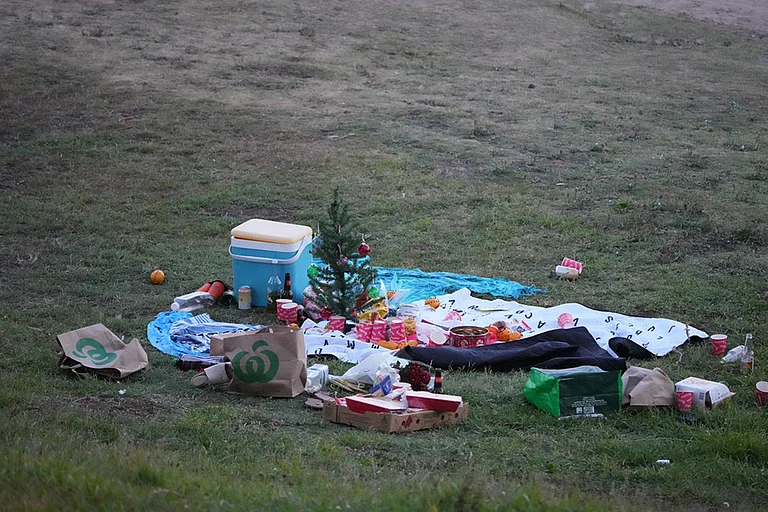Nestled amidst the labyrinthine streets of Fort Kochi, one finds themselves enveloped in a captivating aura of nostalgia, where the whispers of history echo through the pastel-hued facades of charming houses. This locale is the very crucible that earned Kochi its moniker as the "battleground of Europe." The annals of Fort Kochi's past read like a tale of a tumultuous symphony, where the Dutch, British, French, Portuguese, and Jewish chapters have etched their stories upon the very walls of its buildings. While many of these edifices have since been reclaimed by native inhabitants post-independence, remnants of the vibrant cultures that once thrived here persist, evoking the past with a poignant authenticity. Among these remnants, the area formerly inhabited by the Jewish community stands out as a testament to the resilience of heritage preservation.
The eminent author Salman Rushdie, in his literary work The Moor's Last Sigh, offered a prophetic insight into this preservation. Drawing inspiration from his experiences in Kochi, Rushdie mused on the fate of the Jewish community, describing it as "an extinction to be mourned; not an extermination, such as (it) occurred elsewhere." He highlighted the warm reception that the Jews received in Kochi, a stark contrast to the hostility they encountered in other parts of the world. He concluded, "It is the end, nevertheless, of a story that took two thousand years to tell."
A mere stone's throw from the heart of Kochi, lies the enchanting enclave of Mattancherry, often overshadowed by its more renowned neighbour, Fort Kochi. In bygone eras, Mattancherry was a bustling hub of the spice trade, and its legacy persists to this day. This coastal gem, set against the backdrop of the 20th-century spice and tea trade, has seamlessly transformed into a melting pot of cultures, beliefs, customs, and faiths coexisting in harmonious splendour.
The nomenclature of the area, referred to locally as 'cherry,' has a tale of its own. Some locals believe it was once lined with mutton butchering shops, which gave rise to its name. Others claim that foreign traders, grappling with the pronunciation of 'Ancherry Mattom,' simplistically dubbed it 'Matt-Ancherry.' Regardless of its origin, today, Mattancherry beckons as a rustic haven, offering unique attractions and a trove of historical landmarks. Although Mattancherry may be relatively small in size, it promises a delightful diversion from the typical Kochi tour, making it an ideal stopover for a few hours. Conveniently situated adjacent to Fort Kochi, it is easily accessible via various modes of road transport. However, we recommend the scenic boat journey from Ernakulam, which not only provides a refreshing entry into this cultural melting pot but also offers a glimpse of Kerala's enchanting backwaters. The voyage from the man-made Willingdon Islands to the enchanting sights of dolphins gracefully gliding through the waves leaves an indelible mark on one's memory, making this boat ride an experience to cherish.
Kochi, the enchanting port city on India's southwestern coast, has a storied history of welcoming diverse communities, and its exceptional ability to assimilate these groups is a testament to the enduring spirit of tolerance that has characterized the region for centuries. In stark contrast to the turbulent social histories of migration experienced in India and around the world, Kochi's embrace of various ethnicities has created a unique and harmonious cultural landscape.The current phase of big change came on the wings of civic and beautification works done by Cochin Smart Mission Limited prevents Mattancherry from fading into obscurity in the pages of history. Drains have been redone and the entire lane has been cobbled, giving it a European look. There are 11 antique style.
lamp posts and seven three-seater cast iron arm chairs on the lane, The street was repaved with the cobblestones from building to building. Even the drainage covers was made of the stones used to pave the street , As to the installation of the streetlights, An underground duct was laid in the middle of the road so that all the cables and power lines drawn through it and ensuring that the road is not disturbed or dug up.In the evenings when the lights come on, you find people sitting on the chairs reflecting quietly. It’s beautiful.
Over the span of two millennia, many aspects of Kochi have evolved, but the monsoon winds and bustling spice markets, established by intrepid traders who harnessed these winds for global navigation, remain as enduring symbols of this city. The Jews, too, originally arrived following these sea winds and the allure of spices, with motivations ranging from escaping persecution to pursuing trade opportunities. However, these ancient bonds are now slowly unraveling, with only an estimated 4,000 Jews remaining in the entire country, primarily concentrated in Mumbai and Kolkata. Today, India's Jewish connection is primarily with the state of Israel, marked by the rapid expansion of political and security ties that commenced in the early 2000s.
Historian M.G.S. Narayanan, former chairman of the Indian Council of Historical Research, has offered intriguing insights into the history of the Jewish presence in Kochi. According to one narrative, Jews first arrived in Kodungallur, the capital of the Chera Dynasty near Kochi, on ships purportedly belonging to King Solomon during the 1st century BC. These early settlers, known as the Malabari Jews or Black Jews, were later joined by a second generation of Sephardic Jewish immigrants in the 15th century, fleeing the Spanish and Portuguese inquisitions. These newcomers referred to themselves as the 'White Jews' or, in local parlance, the Paradesi Jews.
In 1344, these Jewish communities built India's oldest Jewish temple, the Kochangadi Synagogue. During the Portuguese invasion, they found sanctuary under the benevolent rule of the Hindu Rajah (king) of Kochi, Keshava Rama Varma, who granted them land to establish the Paradesi synagogue and the Jew Town neighborhood. In the post-colonial era, the Jewish professionals reciprocated this generosity by contributing to the construction of the city's first street lamps, ferries, and other civic amenities.
Kochi continues to be home to around 15 distinct ethnic communities, whose origins can be traced back to the Romans, Egyptians, Chinese, Persians, and various regions of India, including Gujarat and Karnataka. In this cosmopolitan environment, religious and cultural traditions coexist harmoniously, as exemplified by the keeper of the local Jain temple being a Hindu Vanniyar and the keeper of the nearby Marathi temple being a Konkani-speaking Kudumbi, a community said to have fled Goa during the Portuguese invasion. During Christmas, the entire town comes alive with celebrations, and the temple's pooja is conducted by Christian festival organizers, while people from diverse backgrounds, including Christians and Muslims, create intricate rangoli designs in front of the temple, a practice that has endured for centuries.
An evening stroll along the beachfront offers a mesmerizing view of Chinese fishing nets, relics of the spice-route era, juxtaposed with Russian tattoo artists, European clubs, Muslim vendors selling beef, strictly vegetarian Konkani bankers, Gujarati traders, Hindu temples, and more. This medley of cultures and traditions converges harmoniously in Kochi's diverse landscape.
Begin your exploration at the Mattancherry Palace, an elegant gift from Portuguese traders to King Veera Kerala Verma, who also referred to it as the 'Dutch Palace.' Most of Mattancherry's landmarks carry multiple names, reflecting the diverse influences of traders and soldiers who have held sway over Kochi's destiny. This two-story palace, constructed in the traditional Kerala 'naalukettu' (quadrangular) architectural style, boasts a rich design, featuring floors made from a blend of burnt coconut shells, lime, plant juices, and egg-whites. The ceilings are adorned with wood-carved designs and brass cups, while the interiors come alive with exquisite mural paintings. Immerse yourself in the history of Kochi's royalty before continuing your journey to the nearby Paradeshi (foreigner) Synagogue.
Kochi, with its remarkable history of embracing diversity, stands as a living testament to the enduring power of tolerance and cultural assimilation. In a world often marked by conflicts arising from migration and cultural differences, Kochi's harmonious coexistence of varied communities serves as an inspiring model for our globalized society. A stroll through the vibrant streets of Jew Street in Mattancherry is like stepping into a time capsule, where antiquity and rustic charm seamlessly weave tales of a bygone era. This historic street stands as a testament to the times when Mattancherry thrived as a prominent hub for Jewish immigrants who arrived on ships and established their roots. Today, the Jewish community in this area is so small that you can literally count its members on your fingers.
The enchanting path leading to the Jewish synagogue is lined with a delightful array of colorful shops, delectable food joints, and captivating artifact stores. The synagogue itself, constructed by the Jewish community of Kochi in the year 1568, proudly boasts the title of being the oldest synagogue in the Commonwealth. Stepping inside is like entering a treasure trove of antiques, from intricately designed tiles imported from China to a mesmerizing chandelier that found its way here all the way from Belgium. The synagogue's resilience shines through its history, as it weathered destruction by the Portuguese in 1662 only to be lovingly restored by the Dutch two years later. Today, it serves as an enduring symbol of the multicultural trade that once thrived in this region. Don't forget to explore the neighboring clock tower and the Jewish cemetery for more glimpses into the past.
"Splendorous" is an understatement when describing the sheer magnificence of this architectural masterpiece. The Paradesi Synagogue, whose name translates to "foreigner," houses a remarkable collection of antiques dating back centuries. The architectural grandeur of the building only adds to its allure. This synagogue, also known as the Jewish Synagogue, was initially constructed in 1568, later suffered damage at the hands of the Portuguese in 1662, and was meticulously restored by the Dutch shortly after. The synagogue's vast central hall, majestic pillars, expansive open windows, exquisite glass chandeliers, vintage lamps, and ceramic floor tiles are a visual feast. History enthusiasts will revel in the myriad rare artifacts within its walls. Situated in the heart of Jew Town in Mattancherry, adjacent to Fort Kochi, this synagogue holds the distinction of being the oldest active synagogue in the Commonwealth of Nations, one of the seven synagogues that continue to be in use in this area.
Leaving behind the bustling Jew Street, the winding lanes of Mattancherry lead to a cluster of weathered, old buildings primarily inhabited by the local fisherfolk. As you navigate your way through this maze, bypassing goats and dogs, you'll stumble upon the Dharmanath Jain Temple. Nestled in the 'Gujarati Colony,' this temple serves as the spiritual heart of Mattancherry's Jain community. Crafted predominantly from pristine white marble, it radiates an aura of serenity amidst the chaos of its surroundings. This enclave is predominantly populated by the descendants of Gujarati settlers who arrived in earlier centuries and continued their trade practices. Be sure to sample the delectable sweets offered by the 'mittai-walas,' which are renowned as some of the best in Kochi.
Continue your journey through these narrow, dimly lit lanes that lead to the epicenter of Mattancherry, the spice market. As you approach, the air becomes heavy with the intoxicating aroma of the finest ginger, cloves, cardamom, turmeric, and the precious "black gold" - pepper. The spice warehouses that line these alleys echo with lively conversations and the hustle and bustle of workers. Witness the mesmerizing spectacle of spice-laden carts moving in and out, as laborers diligently dry, sort, and pack these aromatic treasures. This experience transports you centuries back in time when this locale was a thriving spice trade hub, and the soul of Mattancherry's multicultural heritage pulsates in every corner.
Mattancherry's Jew Street and its environs serve as a vibrant tapestry, weaving together diverse cultures and histories in this quaint corner of Kochi. The synagogues stand as architectural marvels, the Jain Temple exudes tranquility, and the spice market overwhelms the senses, creating a captivating journey through time and culture. In the heart of Mattancherry, the timeless tunes of Mohammad Rafi emanate from radios, harmonizing with the gentle cooing of pigeons that flock to this storied street. As you meander through this charming locale, a soothing ambiance wraps around you, momentarily transporting you from the bustling market to a serene oasis where time stands still.
One of the defining landmarks of this area is the Coonan Cross Shrine, a place steeped in history. In 1653, over 25,000 Christians gathered at this sacred site to take a solemn oath, renouncing their allegiance to Latin Archbishops. Today, the shrine stands as a vibrant spiritual center in Mattancherry, where people of all faiths come to offer their prayers and seek solace. The narrative of Fort Kochi extends beyond the boundaries of Christianity. In the 15th and 16th centuries, Sephardic Jews, often referred to as Paradesi or "foreigners," sought refuge in India after being expelled from Spain. Settling in Cochin, they established their community around the magnificent Synagogue. Synagogue Lane, in the heart of Jew Town, thrived as a residential neighborhood and bustling trading hub until the late 1950s when a wave of migration to Israel began.
A pivotal turning point for the area arrived in the 1990s when local entrepreneurs began acquiring properties. By the early 2000s, the majority of homes had changed hands, now owned by these enterprising locals. The burgeoning tourist industry led to the transformation of many houses into vibrant shops, with Kashmiri traders offering a wide array of exquisite handicrafts. Grand spice warehouses soon emerged, offering antique treasures sourced from the interiors of Kerala and South India. Jew Town swiftly metamorphosed into a bustling marketplace for antiques and spices. The iconic Paradesi Synagogue, albeit closed on Saturdays, continues to draw a steady stream of tourists, with nearly 1,000 visitors gracing its hallowed grounds each day.
Wandering through this neighborhood is like embarking on a journey through the annals of history. On one side, you'll find colonial-era buildings, each a testament to classic European architecture, exuding an air of mystique. On the other side, the majesty of the tranquil Arabian Sea stretches as far as the eye can see. Chinese fishing nets cast a unique silhouette across the landscape, while a plethora of eateries entice with scrumptious culinary delights. It's a symphony of experiences and emotions that envelop you in its warm embrace, compelling you to return time and again.
Mattancherry, a town steeped in yesteryears, is a destination that promises an otherworldly charm you simply can't afford to miss. Kochi's storied history as a meeting point for seafarers from South-East Asia, West Asia, Europe, Africa, and China has made it a true melting pot of cultures—a veritable Disneyland of diversity.





















